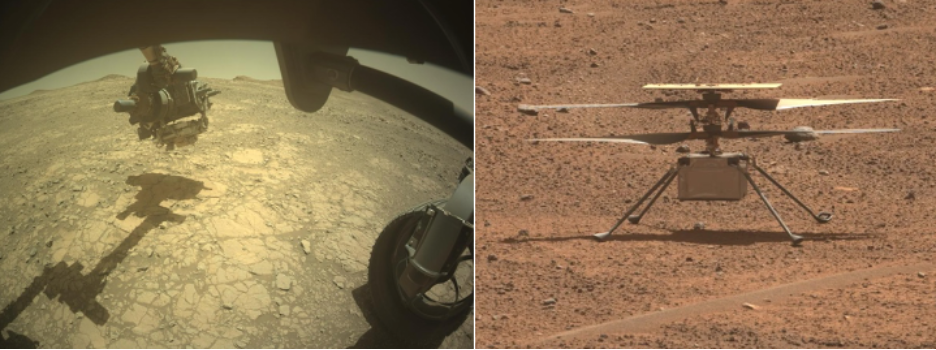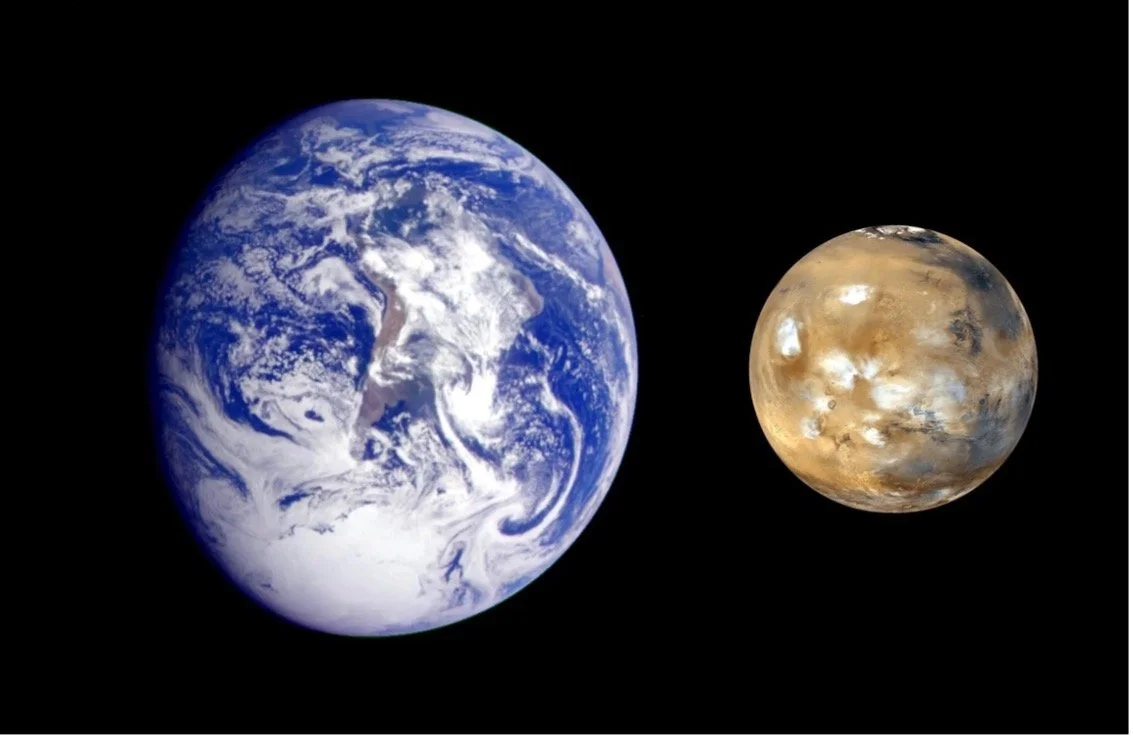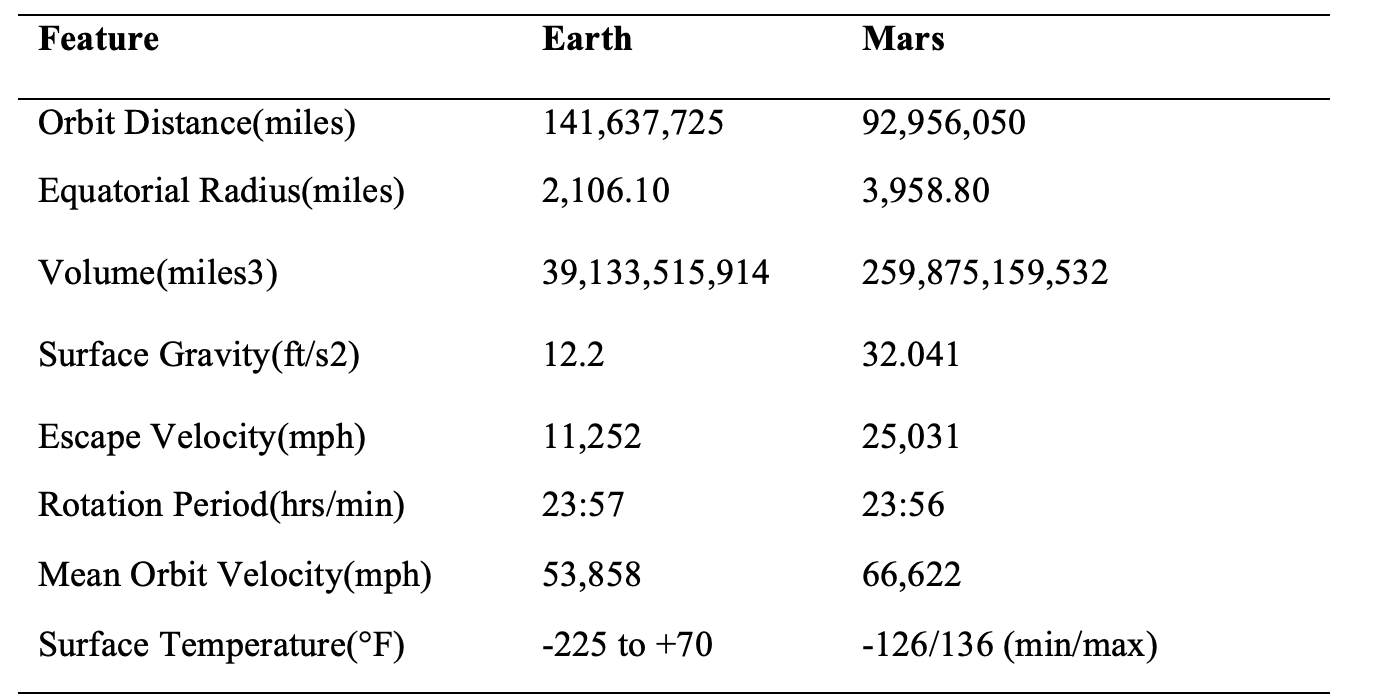Autonomous Navigation for Rovers
A significant challenge in deploying advanced robotics beyond Earth is the need for accurate traversal of unfamiliar terrain––Figure 4 shows the Perseverance rover and Ingenuity Helicopter currently deployed on Mars. Traditionally, this is achieved using human-in-the-loop (HITL) systems, where operators on Earth provide instructions or feedback. However, as the distance increases, communication delays become more pronounced. Even with radio waves––photons traveling at the speed of light, it can take up to 24 minutes for a signal to make a round trip between Earth and Mars. While this delay is negligible on Earth, it poses critical challenges on Mars. Space environments present numerous unique challenges that vary depending on the technology, location, and method of deployment. Key concerns include communication delays, the lack of a magnetic sphere, hazardous terrain––rocks, regolith, and cliffs––and lower gravity levels, all of which impact system performance. For example, unexpected changes in Martian wind conditions or terrain could render preloaded instructions ineffective. This requires the development of autonomous systems capable of real-time decision-making, such as smart navigation systems. This is where Artificial Intelligence methodologies come into play.
Figure 1
Perseverance and Ingenuity
Note. This image shows the remains of an ancient delta in Mars’ Jezero Crater, which NASA’s Perseverance Mars rover will explore for signs of fossilized microbial life (left) and This view of NASA’s Ingenuity Mars Helicopter was generated using data collected by the Mastcam-Z instrument aboard the agency’s Perseverance Mars rover. NASA/JPL-Caltech/ASU/MSSS (right) [53, 54].
Geography and surface features
Since early observations of Mars in the 1500s, astronomers have often interpreted the planet's terrain through the lens of their own biases and limitations. Using rudimentary telescopes, they created maps based on what they believed they saw through their lenses. However, these depictions were far from accurate. For instance, astronomers were unaware of the massive, planet-wide dust storms that regularly engulf Mars, obscuring its surface. Additionally, some mistakenly interpreted surface features as artificial canals, leading to further misconceptions about the planet's geography. It wasn’t until the 1960s and 1970s, with missions like Mariner 4, Mariner 9, and subsequent orbiters, that humanity obtained its first true images of Mars' surface, revealing its actual terrain.
Figure 2
Earth-Mars Comparison
Note. Earth-Mars Comparison: This composite image, from NASA Galileo and Mars Global Survey orbiters, of Earth and Mars was created to allow viewers to gain a better understanding of the relative sizes of the two planets. JPL [49].
Table 1
Earth-Mars Comparison
Note. A comparison between Earth and Mars. Key feature difference. Retrieved from NASA [64].
Physiology of Mars
Atmospheric conditions, temperature variations, and radiation exposure
It’s important to consider the differences between Earth and Mars––shown in Figure 2 and Table 1 despite both being rocky planets with some similarities, Mars’ atmospheric pressure is significantly lower than Earth’s, and its gravity is about 37% that of Earth. Combined with Mars’ thinner atmosphere and lack of a magnetic field, these differences pose significant challenges for deploying technologies. For instance, variations in atmospheric pressure affect the boiling and freezing points of substances, which has implications for managing resources and systems. Why does this matter? Considering the laws of thermodynamics, when a Neural Network is in its training phase, moving electrons through transistors generates heat. This occurs as particles release energy while transitioning from a lower to a higher entropy state. The more computational resources required, the more heat is generated––an issue intensified by Mars’ environmental constraints.
Lack of magnetic sphere
Earth protects us and our technology by shielding against harmful radiation, thanks to its active magnetic field, known as the magnetosphere. This magnetic field extends outward into space, forming a protective layer that deflects charged particles from the Sun and cosmic rays. Satellites in Low Earth Orbit (LEO) are positioned relatively close to Earth and benefit from this protection, but technologies deployed beyond Earth face harsher conditions. However, satellites at specific Lagrange points––positions in space where the gravitational forces of two large bodies (like Earth and the Sun) balance with the centrifugal force of a smaller object––may be less protected by the magnetosphere depending on their location. These satellites are crucial for modern communications but are still less exposed to radiation compared to technologies operating further away from Earth. Mars, by contrast, lacks a thick atmosphere and a magnetic field, leaving its surface exposed to high-energy particles, including photons, which can damage components. When designing technologies for deep space missions, engineers must account for the increased exposure to harmful radiation. This requires the use of radiation hardening, a process of designing and testing components to withstand the intense radiation environments encountered outside of Earth's protective magnetic field.
Figure 3
Jezero Crater
Note. This image shows the remains of an ancient delta in Mars’ Jezero Crater, which NASA’s Perseverance Mars rover will explore for signs of fossilized microbial life [55].
Mars’ extreme environment––shown in Figure 3––also presents other challenges, such as severe cold. For example, Curiosity tested dry lubricants to endure the cold, but they failed to meet durability requirements during rigorous testing. These conditions require advanced engineering solutions, such as the radiation hardening mentioned earlier, to ensure components can withstand both radiation and extreme temperatures, enabling long-term functionality in deep space. Understanding these challenges is essential for ensuring the longevity and functionality of space-based technologies.
Durability of hardware in extreme Martian conditions (Radiation Hardening)
Radiation hardening is a rigorous and time-intensive process. As a result, space missions often rely on older, proven components that have a track record of reliability in extreme conditions. However, this can lead to limitations, such as using older chips with far less computational power than modern consumer devices. For instance, your current smartphone likely has more processing power than the computers used to send the first manned mission to the Moon. In 1965, Gordon Moore predicted that the number of transistors on a chip would double every 10 years, revising it in 1975 to every 18-24 months––this became known as Moore’s Law. It has driven semiconductor advancements, but as transistors shrink below a certain threshold––there’s uncertainty around the actual size, they approach what’s known as the fuzzy quantum limit. At this scale, quantum effects such as electron tunneling and uncertainty disrupt the traditional flow of electrons through transistors, making further miniaturization impractical. Quantum computing seeks to overcome these limitations by leveraging quantum phenomena such as superposition and entanglement. However, returning to radiation-hardened components, their inherent limitations often mean they lack the advanced computational power necessary to run modern AI techniques on the Martian terrain.
Power consumption in AI systems
A critical consideration for AI systems in space is power consumption, an often-overlooked challenge that becomes crucial outside of Earth. On Earth, we have the luxury of scaling up compute power, resources, and energy as needed. On Mars, however, energy sources are limited solar and nuclear options. Solar power becomes unreliable during atmospheric events like dust storms, which can block sunlight and significantly reduce energy output, as well as regolith blocking the solar panels. Nuclear power––while more reliable and efficient––is primarily used to keep rovers operational by maintaining critical systems and protecting them from the extreme cold on Mars. This leaves little surplus energy for running power-intensive AI systems, making energy efficiency a key design priority.
The Foreseeable Future
For the foreseeable future, space exploration will rely heavily on robotic systems. While SpaceX has planned Mars missions, we remain far from sending humans to most celestial objects. Both the Moon and Mars are promising candidates for exploration—though only the Moon has hosted humans—but ensuring human safety requires advancements in artificial gravity, synthetic biology, and radiation-resistant spacecraft. Until these technologies are thoroughly tested and proven, society will remain cautious about placing humans in harm's way for what some consider a non-essential pursuit. Robotic systems continue to bridge this gap, as demonstrated by their successes in underwater, aerial, and space missions. These technologies allow us to test scenarios and develop smarter, more adaptive systems capable of interacting with their environments in innovative ways.
Humans often consider themselves the most intelligent species, yet our cognitive abilities are limited by the small window of visible light we perceive within the Electromagnetic Spectrum. For instance, bees can see ultraviolet light, which is invisible to us, due to their unique biology. Similarly, humans emit infrared radiation, which we cannot see without specialized tools. By leveraging wavelengths outside visible light, such as infrared, ultraviolet, and X-rays, we can explore the universe in entirely new ways. These tools enable us to better understand terrain, particularly on Mars, enhancing computational models with AI to create more detailed, multidimensional representations of the environment. However, challenges like energy efficiency, thermal output, Martian dust storms, and limited in situ resources persist. Overcoming these obstacles requires a multi-faceted approach, integrating incremental advancements across disciplines rather than relying on a single solution.
References
Lakdawalla, E. (2018). The Design and Engineering of Curiosity: How the Mars Rover Performs its Job. Springer.
Manning, R., & Simon, W. (2014). Mars rover Curiosity: An Inside Account from Curiosity's Chief Engineer. Smithsonian Institution.
Ehrenfried, M. (2022). Perseverance and the Mars 2020 mission: Follow the Science to Jezero Crater. Springer Nature.
Crumpler, L. (2021). Missions to Mars: A New Era of Rover and Spacecraft Discovery on the Red Planet. HarperCollins.
Lee, K. (2018). AI superpowers: China, Silicon Valley, and the New World Order. Houghton Mifflin.
Tyson, N. D. (2022). Starry messenger: Cosmic Perspectives on Civilization. Henry Holt and Company.
Tyson, N. D. (2017). Astrophysics For People in a Hurry. W. W. Norton & Company.
NASA. (2022). Mars Pathfinder mission overview. Retrieved from https://mars.nasa.gov/MPF/rover/mission.html
NASA. (2022). Mars exploration historical log. Retrieved from https://mars.nasa.gov/mars-exploration/missions/historical-log/
Patel, D. (2023). Artificial intelligence & generative AI for beginners.
11. Kelleher, J. (2019). Deep learning. MIT Press.
12. Committee on Scientific Use of the Radio Spectrum. (2010). Spectrum management for science in the 21st century. National Academies Press.
13. Kissinger, H., Schmidt, E., & Huttenlocher, D. (2022). The Age of AI and Our Human Future. Little, Brown and Company.
14. Sheehan, W., et al. (2021). Discovering Mars: A history of observation and exploration of the red planet. University of Arizona Press.
15. Zhang, S., et al. (2020). Deep SCNN-based real-time object detection for self-driving vehicles using lidar temporal data. IEEE Access, 8, 76903–76912. https://doi.org/10.1109/ACCESS.2020.2984855
Quigley, C. (2023). Simply Artificial Intelligence. DK.
Morden, S. (2022). The red planet: A Natural History of Mars. Pegasus Books.
Domingos, P. (2018). The master algorithm: How the quest for the ultimate machine will remake our world. Basic Books.
Kaku, M. (2023). Quantum supremacy. Doubleday.
Kaku, M. (2023). The God equation: The quest for a theory of everything. Double Day.
Tyson, N. D. (2023). To infinity and beyond: A journey of cosmic discovery. National Geographic.
Madi, M., et al. (2024). Artificial intelligence for space: Trends, applications, and perspectives. CRC Press.
Leracitano, C., et al. (2024). The use of artificial intelligence for space applications: Workshop at the 2022 International Conference on Applied Intelligence and Informatics. Springer.
Heuer, R. (2018). Psychology intelligence analysis. Military Bookshop.
Schmidt, E., et al. (2021). Final report | National Security Commission on Artificial Intelligence. Retrieved from https://www.nscai.gov/
Ferrie, C. (2023). Quantum Bullsh*t: How to Run Your Life with Advice from Quantum Physics. Sourcebooks.
Zubrin, R. (2024). The new world on Mars: What we can create on the red planet. Penguin Books Limited.
Chodos, A., et al. (2023). Ghost particle: In search of The Elusive and Mysterious Neutrino. MIT Press.
Weinersmith, K., & Weinersmith, Z. (2023). A city on Mars: Can we settle space, should we settle space, and have we really thought this through? Penguin Press.
Jackson, T. (2020). The periodic table: A visual guide to the elements. DK Publishing.
Cox, B., & Forshaw, J. (2022). Black holes: The key to understanding the universe. Mariner Books.
Christian, B., & Griffiths, T. (2016). Algorithms to live by: The computer science of human decisions. Henry Holt and Company.
Loeb, A. (2023). Interstellar: The search for extraterrestrial life and our future in the stars. Houghton Mifflin Harcourt.
DK. (2020). How the brain works: The facts visually explained.
Webb, A., & Hessel, A. (2022). The genesis machine: Our quest to rewrite life in the age of synthetic biology. Blackstone Pub.
Crawford, K. (2021). Atlas of AI. Yale University Press.
Susskind, L., & Cabannes, A. (2023). General relativity: The theoretical minimum. Basic Books.
Carroll, S. (2024). The biggest ideas in the universe: Quanta and fields. Dutton.
Tyson, N. (2024). Merlin’s tour of the universe: A traveler’s guide to blue moons and black holes, Mars, stars, and everything far. Blackstone Publishing
Chiang, H.-S., Sangaiah, A. K., Chen, M.-Y., & Liu, J.-Y. (2020). A novel artificial bee colony optimization algorithm with SVM for bio-inspired software-defined networking. International Journal of Parallel Programming, 48(2), 310–328. https://doi.org/10.1007/s10766-018-0594-6
Azam, M. A., et al. (2021). Hybrid ant swarm-based data clustering. IEEE World AI IoT Congress (AIIoT), 2021, 0170–0173. https://doi.org/10.1109/AIIoT52608.2021.9454238
Kavyashree, N., et al. (2024). AI in space. Grenze International Journal of Engineering & Technology (GIJET), 10(2), 6297–6302.
NASA. (2022). Communications with Earth | Mission – NASA Mars Exploration. Retrieved from https://mars.nasa.gov/msl/mission/communications/
Barnell, M., et al. (2023). Advanced ultra-low-power deep learning applications with neuromorphic computing. IEEE High Performance Extreme Computing Conference (HPEC), 2023, 1–4. https://doi.org/10.1109/HPEC58863.2023.10363561
Gautam, A., & Sharma, S. (2024). Artificial narrow intelligence inspired neuromorphic computing for logic operations in healthcare appliances. IEEE ICCPCT, 2024, 714–719. https://doi.org/10.1109/ICCPCT61902.2024.10672744
NASA. (2025, January 25). Discover Mars. Retrieved from https://science.nasa.gov/mission/mars-sample-return/
Ni, J., Zhang, Z., Su, B., Fan, X., & Liang, W. (2017). A bio-inspired neural network-based PSO method for robot path planning. 13th International Conference on Natural Computation, Fuzzy Systems and Knowledge Discovery (ICNC-FSKD), 2017, 234–238. https://doi.org/10.1109/FSKD.2017.8393137
NASA. (2025, January 25). Why do we go? Retrieved from https://science.nasa.gov/mars/
NASA. (2025, January 25). Mars exploration. Retrieved from https://science.nasa.gov/planetary-science/programs/mars-exploration/
Omar, A. A., Farag, M. M., & Alhamad, R. A. (2021). Artificial intelligence: New paradigm in deep space exploration. 14th International Conference on Developments in eSystems Engineering (DeSE), 2021, 438–442. https://doi.org/10.1109/DeSE54285.2021.9719425
Ylaya, V. J., Alvarez, A. R., Benasing, P., Gerasta, O. J. L., Caberos, A. B., & Pandian, N. M. (2019). Artificial intelligent (AI) signal processing approach of subsurface electromagnetic radar. 19th International Symposium on Communications and Information Technologies (ISCIT), 2019, 452–457. https://doi.org/10.1109/ISCIT.2019.8905214
NASA. (2025, January 25). Mars Perseverance Sol 1396: Front right hazard avoidance camera (Hazcam). Retrieved from https://mars.nasa.gov/mars2020/multimedia/raw-images/
NASA. (2025, January 25). Mars Ingenuity Helicopter. Retrieved from https://science.nasa.gov/mission/mars-2020-perseverance/
NASA. (2025, January 25). Landing site: Jezero Crater. Retrieved from https://science.nasa.gov/mission/mars-2020-perseverance
Wikipedia. (2025, January 25). Electromagnetic spectrum. Retrieved from https://en.wikipedia.org/wiki/Electromagnetic_spectrum
Intel. (2025, January 25). Taking neuromorphic computing to the next level with Loihi 2. Retrieved from https://www.intel.com/content/www/us/en/research/neuromorphic-computing-loihi-2-technology-brief.html
NASA. (2025, January 25). Closer and closer. Retrieved from https://science.nasa.gov/solar-system/skywatching/night-sky-network/jan2025-night-sky-notes/
NASA. (2025, January 25). Deep Space Network. Retrieved from https://www.nasa.gov/communicating-with-missions/dsn/
Mittal, M., Dewan, P., Panesar, T., & Singh, M. (2024). Educating a robot to walk on Mars using artificial intelligence. 11th International Conference on Computing for Sustainable Global Development (INDIACom), 2024, 1137–1143. https://doi.org/10.23919/INDIACom61295.2024.10498720
Aru, J., Verreycken, E., Laurijssen, D., & Steckel, J. (2022). 3D sonar on Mars. IEEE Sensors, 2022, 1–4. https://doi.org/10.1109/SENSORS52175.2022.9967191
Haj Youssef, K. A., Zayegh, Y., & Alkhedher, M. (2024). Autonomous AI-controlled Mars rover robot. Advances in Science and Engineering Technology International Conferences (ASET), 2024, 1–7. https://doi.org/10.1109/ASET60340.2024.10708660
NASA. (2025, February 18). Mars fact sheet. Retrieved from https://nssdc.gsfc.nasa.gov/planetary/factsheet/marsfact.html
Wilhelm, T., Komann, D., & Wohler, C. (2022). Machine learning on Mars: Open challenges, similarities and differences to Earth remote sensing. IGARSS 2022 - IEEE International Geoscience and Remote Sensing Symposium, 2022, 5373–5376. https://doi.org/10.1109/IGARSS46834.2022.9884096
NASA. (2025, February 18). Taking neuromorphic computing to the next level with Loihi 2. [Photo]. Retrieved from https://www.intel.com/content/www/us/en/research/neuromorphic-computing-loihi-2-technology-brief.html
NASA. (2025, February 18). Deep Space Network. [Photo]. Retrieved from https://www.nasa.gov/communicating-with-missions/dsn/
Anathaswamy, A. (2024). Why Machines Learn: The Elegant Math Behind Modern AI. Penguin Random House LLC.
Benjamin, A. (2015). The Magic of Math: Solving for X and Figuring Out Why. Hatchet Book Group.
Kaku, M. (2014). The Future of The Mind: The Scientific Quest to Understand, Enhance, and Empower the Mind. Anchor Books.
Greene, B. (2011). The Hidden Reality: Parallel Universes and the Deep Laws of the Cosmos. Vintage Books.
Markel, H. (2021). The Secret of Life: Rosalind Franklin, James Watson, Francis Crick, and the Discovery of DNA's Double Helix. W.W. Norton & Company.
Amthor, F. (2023). Neuroscience for Dummies (3rd ed.). John Wiley & Sons, INC.




